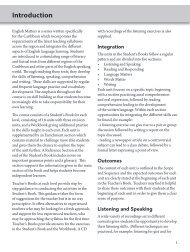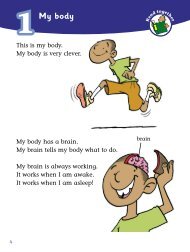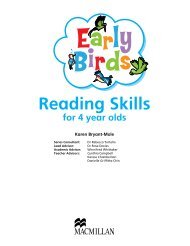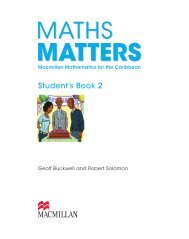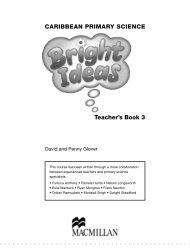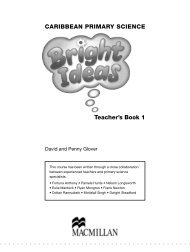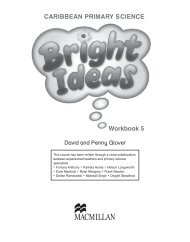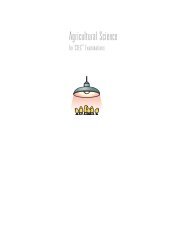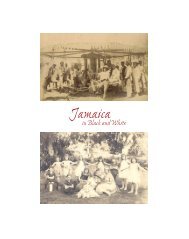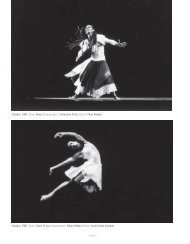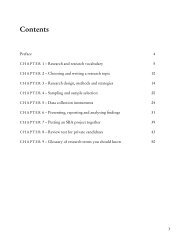CARIBBEAN PRIMARY SCIENCE Teacher's Book 2 - Macmillan ...
CARIBBEAN PRIMARY SCIENCE Teacher's Book 2 - Macmillan ...
CARIBBEAN PRIMARY SCIENCE Teacher's Book 2 - Macmillan ...
You also want an ePaper? Increase the reach of your titles
YUMPU automatically turns print PDFs into web optimized ePapers that Google loves.
<strong>CARIBBEAN</strong> <strong>PRIMARY</strong> <strong>SCIENCE</strong><br />
Teacher’s <strong>Book</strong> 2<br />
David and Penny Glover<br />
This course has been written through a close collaboration<br />
between experienced teachers and primary science<br />
specialists.<br />
• Fortuna Anthony • Pamela Hunte • Nelson Longsworth<br />
• Eulie Mantock • Ryan Mongroo • Frank Newton<br />
• Doltan Ramsubeik • Motielall Singh • Dwight Steadford<br />
BITB2_00prelims(1-27).indd 1<br />
11/24/10 10:09:02 AM
Contents<br />
Introduction 5<br />
What is science 5<br />
Why teach science in the primary school 6<br />
The primary science curriculum 7<br />
Using Bright Ideas with your curriculum 8<br />
Lesson planning 9<br />
Resources for science teaching 12<br />
<strong>Book</strong>s, songs, poetry, raps and rhymes 15<br />
Field work and visits 15<br />
Displays 17<br />
Assessing children’s progress in science 17<br />
Developing children’s scientific vocabulary 18<br />
Developing science process skills 18<br />
Science process skills in Bright Ideas 25<br />
Safety 25<br />
Lesson plans 28<br />
Unit 1 Living things 28<br />
Unit 2 The environment 42<br />
Unit 3 Matter and materials 51<br />
Unit 4 Structures and machines 63<br />
Unit 5 Forces and energy 70<br />
Unit 6 The Earth in space 85<br />
Resources<br />
Bright Ideas Workbook 2 answers 91<br />
Action songs and rhymes for Year 2 Science 96<br />
Planning grids 98<br />
Bright Ideas Year 2 Scope and Sequence 101<br />
BITB2_00prelims(1-27).indd 3<br />
11/24/10 10:09:03 AM
Series preface – Bright Ideas<br />
The Bright Ideas series is a comprehensive science course for all students in primary schools.<br />
Building on practical experience and investigation, the books follow current best practice in<br />
science education. Through engaging content and carefully graded activities and exercises,<br />
students are guided to develop a sound framework of scientific knowledge, understanding and<br />
skills. There are seven full-colour Student’s <strong>Book</strong>s from kindergarten level to the final year of<br />
primary school. Each Student’s <strong>Book</strong> is accompanied by a Workbook.<br />
This Teacher’s <strong>Book</strong> provides detailed support for teachers using the Year 2 Student’s <strong>Book</strong> as the<br />
basis for their science teaching through the school year. The introduction starts with a discussion<br />
of the question ‘What is science’ and sets out the case for teaching investigative science in the<br />
primary school. Subsequent sections deal in turn with the primary science curriculum; matching<br />
the content of Bright Ideas to your curriculum; lesson planning and preparation; resources for<br />
science teaching; field work and visits; displays; assessment; developing science process skills;<br />
and safety in science teaching.<br />
Pages 28–90 of the guide present sample lesson plans for each of the 44 lessons in the Student’s<br />
<strong>Book</strong>s. Each lesson plan lists the lesson objectives and the resources required. There are ideas<br />
for starter activities and lesson development and suggestions for summarising and evaluating the<br />
lesson. There are also suggestions for extension activities, cross-curriculum links and answers to<br />
the Student’s <strong>Book</strong> questions.<br />
On pages 98–100 you will find printable grids and planning forms to assist your planning and<br />
record keeping.<br />
Science teaching, especially when it is ‘hands-on’, can be highly enjoyable and rewarding for<br />
teachers and students alike. We hope that the Bright Ideas course will contribute both to the<br />
effectiveness of your teaching and to the pleasure that you and your class gain from studying<br />
science.<br />
David and Penny Glover<br />
<br />
BITB2_00prelims(1-27).indd 4<br />
11/24/10 10:09:03 AM
Introduction<br />
What is science<br />
For most of history, science had little to do with the everyday lives of ordinary people. This is not<br />
true today. From antibiotics and X-rays, through mobile phones and the internet, to hurricane<br />
tracking by satellite and the impact of global warming – the discoveries and applications of<br />
science affect all our lives. Indeed, it would not be unreasonable to claim that science has created<br />
the modern world.<br />
So what exactly is science A partial answer to this question is that science is the body of<br />
knowledge – observations, ideas and explanations – assembled by scientists through generations<br />
of painstaking investigation of the natural world. This knowledge is recorded in books and journals<br />
that fill miles of shelving in the world’s great libraries. Subdivided into major subject areas such as<br />
Physics, Chemistry, Biology, Geology and Astronomy, the creation of this intellectual wealth is a<br />
wonderful human enterprise that continues today at an ever increasing rate.<br />
Great as this enterprise is, if that’s all there was to science then, apart from the small percentage<br />
of the population who work as professional scientists, most of us could only ever hope to be<br />
spectators to the discoveries of science and consumers of its applications. But this is certainly not<br />
the case. We can all think and work as scientists; even five-year-olds in their first year at school<br />
can be scientists as they discover the wonders of the world in which they live.<br />
That this is so is because science is not just a body of knowledge, it is also a process for<br />
investigating and understanding the things around us and for checking that our ideas and<br />
explanations are correct. The essence of the scientific method is simply stated. Scientific<br />
understanding is based on:<br />
● evidence collected from the real world<br />
● careful observations and measurements that can be checked by others<br />
● explanations (theories) that make predictions which can be tested by further observation and<br />
experiment.<br />
Other key features of the scientific way of thinking and working include important attitudes<br />
towards knowledge and learning:<br />
● questioning – constant curiosity about how and why things are as they are<br />
● respect for evidence – including the willingness to change accepted views of the world when<br />
new evidence contradicts previously held ideas or beliefs<br />
● collaboration – working with others, sharing ideas and resources to make new discoveries and<br />
to solve problems.<br />
The scientific method and attitudes are thus not only relevant to the work of high-powered<br />
professors in sophisticated laboratories – they have a role in most aspects of life. Whether it is a<br />
householder trying to reduce energy bills, a car driver trying to work out why his or her car won’t<br />
start, a local politician trying to solve the problems of waste disposal in a community, or countless<br />
similar challenges we face in our working and daily lives, thinking scientifically has proved to be<br />
the most reliable and efficient method for solving practical problems, as well as for discovering<br />
new knowledge.<br />
<br />
BITB2_00prelims(1-27).indd 5<br />
11/24/10 10:09:04 AM
I N T R O D U C T I O N<br />
Why teach science in the primary school<br />
A generation ago science was not commonly taught as a separate subject in primary schools.<br />
At best, there would be some nature study and a few model-making activities – which might<br />
expose children to some simple applications of science in technology – but investigations and<br />
experiments were not on the menu until secondary school and, even then, the emphasis was<br />
often more on learning about science, rather than learning to do science.<br />
With the move away from the didactic ‘chalk-and-talk’ approach to education, towards a more childcentred<br />
model of learning that took place from the 1960s onwards, science gradually took its place<br />
in the primary curriculum. Experiments with discovery learning and new educational theories, which<br />
emphasised the importance of children ‘constructing’ their own understanding through first-hand<br />
experiences and by sharing their ideas with others, developed in parallel with the growing influence<br />
of science and technology in society. As politicians recognised the importance of science education<br />
for economies and society in general, educators discovered the value of the hands-on approach to<br />
science in motivating and enhancing children’s intellectual development in the primary school.<br />
Investigative science motivates and<br />
promotes real learning<br />
Today, the case for teaching primary science hardly needs to be stated. Science, alongside<br />
numeracy and literacy, is a core component of the primary school curriculum in schools around<br />
the world. The reasons for teaching science at the primary level may be summarised as follows:<br />
● investigation-based science learning develops children’s curiosity, problem solving, practical<br />
and communication skills<br />
● basic scientific knowledge of the human body, diet, living things, the environment, materials,<br />
forces and energy contributes to children’s developing awareness of themselves and their<br />
relationship to their surroundings; this knowledge will help them to make healthy choices, to<br />
keep safe and to solve problems as they move through life<br />
● scientific values and attitudes such as respect for evidence, questioning, flexible thinking and<br />
the willingness to share knowledge and ideas are relevant in all areas of children’s learning, not<br />
just science<br />
● through science, children become aware of environmental issues and the impact that they<br />
as individuals can have on their surroundings; they develop respect for living things and their<br />
environment and become aware of the harm that simple actions such as littering, wasting<br />
energy or contaminating water supplies can cause<br />
● in the majority of countries science is an examination subject at the end of the final year of<br />
primary school. Children may need to perform well in science to gain a place at the secondary<br />
school of their choice<br />
<br />
BITB2_00prelims(1-27).indd 6<br />
11/24/10 10:09:05 AM
I N T R O D U C T I O N<br />
● a good knowledge of science gained in the primary school prepares children to do well in their<br />
more formal science education at secondary school. Good results in secondary school science<br />
examinations open up a wide range of career opportunities.<br />
The primary science curriculum<br />
A preliminary reading of primary science curriculum documents from the countries of the<br />
Caribbean Region and beyond suggests that each is highly individual, with less in common<br />
between the specifications from different countries than for, say, numeracy and literacy.<br />
However, a more thorough analysis shows that, although different topics may be tackled in<br />
different years and there are some country-specific contexts and examples through which<br />
science is taught, the majority of themes are common to all primary science syllabus documents.<br />
Table 1 identifies the core science themes that almost invariably appear at different points in the<br />
kindergarten and the six years of primary school.<br />
Table 1 Themes common to the majority of primary science syllabuses<br />
Theme 1<br />
How science works<br />
Theme 2<br />
The human body<br />
Theme 3<br />
Plants and animals<br />
Theme 4<br />
The environment<br />
Theme 5<br />
The Earth and its features<br />
Theme 6<br />
Materials and their<br />
properties<br />
Theme 7<br />
Forces and energy<br />
Theme 8<br />
Space<br />
Scientific enquiry and investigation skills: observing, questioning, classifying,<br />
measuring, planning; hypothesising, evaluation, concluding, etc.<br />
Body parts and processes: senses and sense organs, health and hygiene,<br />
growth, reproduction, organs and organ systems, digestion, nutrition,<br />
disease, healthy lifestyles, etc.<br />
Living things: classification, variety, body parts and systems, life processes,<br />
interactions, life cycles, photosynthesis, useful plants and animals, caring for<br />
animals, gardening, etc.<br />
Habitats and ecosystems: interdependence, different ecosystems, threats<br />
to the environment, pollution, deforestation, global warming, endangered<br />
species, sustainable development, etc.<br />
The structure and components of the Earth: characteristics of rocks and soil,<br />
rock and soil formation, minerals and their uses, landforms, the atmosphere,<br />
weather conditions, climate, water supply, the water cycle, natural disasters,<br />
etc.<br />
Properties and uses of materials: wood, plastic, metal, glass, etc., matching<br />
materials to their applications, conductors and insulators, shaping materials,<br />
using tools, natural and synthetic materials, simple structures, etc.<br />
Force, energy and movement: the effects of forces, types of force, friction,<br />
gravity, simple machines, energy types and sources, fossil fuels and global<br />
warming, alternative energy sources, the characteristics and uses of heat,<br />
light and sound, sources and uses of electricity, simple circuits, magnetism<br />
and its applications, etc.<br />
The Earth in space: the Earth, the Sun and the Moon, day and night, the<br />
seasons, the tides, the phases of the Moon, eclipses, the solar system,<br />
characteristics of the planets, space travel, stars and galaxies, the Universe,<br />
etc.<br />
In practice, each theme is revisited several times as children progress through the school. Topics<br />
from a given theme, the human body, for example, are taught in different year groups – both as the<br />
syllabus demands and as the children become ready to deal with the topic at the depth required.<br />
The main external parts of the human body will probably be introduced in the kindergarten, but the<br />
internal organs and their detailed functions will probably not be covered until Years 5 or 6. Children<br />
progress at different rates and so the opportunity to revisit a topic gives the chance to reinforce<br />
and develop understanding; a topic which had been only partly understood in an earlier year may<br />
be grasped more fully when it is met again and taken further in later years.<br />
<br />
BITB2_00prelims(1-27).indd 7<br />
11/24/10 10:09:05 AM
I N T R O D U C T I O N<br />
plants Y6 animals human energy body: space<br />
materials Earth digestive ecosystems<br />
magnetism Y5 electricity plants<br />
animals energy human space body: force<br />
materials Earth ecosystems<br />
Y4<br />
internal organs<br />
magnetism electricity plants<br />
animals energy human space body: force<br />
materials Y3 Earth diet and ecosystems health<br />
magnetism electricity plants<br />
animals Y2 energy human space body: force<br />
materials Earth growth ecosystems<br />
magnetism Y1 electricity plants<br />
animals energy human space body: force<br />
materials Earth ecosystems<br />
K<br />
external parts<br />
The spiral curriculum. Progression through the primary<br />
science curriculum is more akin to a spiral than a straight line.<br />
Children revisit ideas and take them to a higher level as they<br />
progress up the learning spiral.<br />
Themes 2–8 in Table 1 are the knowledge-based areas of the curriculum – the traditional ‘content’<br />
of science. As children work on these themes they learn the basic facts of science – facts about<br />
living things, materials, energy, the planets and so on, but they should not be passive absorbers of<br />
facts. Learning is more effective when learners are actively engaged with the topic: planning and<br />
carrying out investigations, participating in discussions, using the library or the internet to conduct<br />
research for a poster or a display. It is Theme 1 ‘How science works’ that is concerned with the<br />
processes, skills and attitudes of science. As children put these skills into practice, they become<br />
scientists themselves and the syllabus content is brought to life.<br />
In some syllabus documents, science skills are listed in the overall aims of the course; in others they<br />
may be set out as a separate set of objectives in a section similar to the objectives for the knowledgebased<br />
themes. Wherever they appear in the syllabus, it is important we recognise that science skills<br />
cannot be taught in isolation, but should be introduced in real contexts. The idea of a ‘fair test’, for<br />
example, might be introduced when children compare the conditions in which seeds germinate in Years<br />
1 or 2. The concept of fairness can then become part of investigations in all parts of the curriculum.<br />
Using Bright Ideas with your curriculum<br />
The Bright Ideas course has been written for use throughout the Caribbean Region. In developing<br />
the course, syllabus documents from around the region were examined to select the topics for<br />
inclusion. Our aim has been to produce a comprehensive course which includes all the topics at<br />
each level that teachers will need to satisfy their syllabus requirements. This means that:<br />
● each Student’s <strong>Book</strong> contains more material than will be required for any one syllabus<br />
● teachers must select the material they need for their syllabus<br />
● ‘extra’ material is available in each book for extension and enrichment.<br />
The Student’s <strong>Book</strong>s have been structured to make the selection task as straightforward as<br />
possible. The content has been carefully broken down into self-contained two or three page<br />
‘lessons’. The lessons are grouped as subject Units.<br />
Each lesson includes the following elements:<br />
● list of lesson objectives<br />
● main content illustrated with artwork and/or photographs<br />
<br />
BITB2_00prelims(1-27).indd 8<br />
11/24/10 10:09:06 AM
I N T R O D U C T I O N<br />
● one or more activities (these are a mixture of experiments, group work and pencil-and-paper<br />
activities)<br />
● often a fascinating fact box<br />
● key words<br />
● a copy-and-complete summary of key learning points<br />
● one or two review questions.<br />
The learning objectives for each lesson are clearly stated in the Student’s <strong>Book</strong>s in the box<br />
following the lesson title. For example, for Unit 1, Lesson 1 of Year 2:<br />
How plants grow<br />
OBJECTIVES<br />
When you have completed this lesson you will be able to:<br />
● describe how living things grow gradually<br />
● record the germination and growth of different seeds<br />
● arrange pictures of seedlings in order<br />
The knowledge and skills areas supported by the lesson are summarised in the scope and<br />
sequence table at the back of the Student’s <strong>Book</strong> and Teacher’s <strong>Book</strong>. For example:<br />
Lesson Title Science Knowledge Science Skills<br />
UNIT 1 LIVING THINGS<br />
How plants grow<br />
Living things grow gradually<br />
The germination and growth of seeds<br />
observing; investigating;<br />
measuring; recording;<br />
communicating<br />
To assist your planning, all this information is brought together as a series of printable planning<br />
grids at the back of this guide. You can use copies of the planning grids together with your<br />
syllabus document to identify those lessons you will be teaching through the school year. Use the<br />
blank columns in the grids to add additional comments and information as required.<br />
Lesson planning<br />
The Student’s <strong>Book</strong> provides the basis for individual lessons, with the core content, activities and<br />
questions to reinforce and review the students’ learning. Occasionally you may wish to base an<br />
entire lesson around book-work, but science lessons would be dull and repetitive if they were<br />
all taught ‘by-the-book’. In general, lessons should be individually planned, with a variety of<br />
resources used alongside the book. At various stages of the lesson, students may be engaged in<br />
discussion with each other and/or the teacher, question-and-answer, practical work, observing<br />
demonstrations, drawing or note making, answering written questions, reciting poems and<br />
rhymes, singing and other activities (though not necessarily all of the above in any one lesson!)<br />
The key to a good lesson is good planning. The form below is an outline lesson plan for a science<br />
lesson. The sections have been completed with explanations of the kinds of activities the teacher<br />
and the children should be engaged in at different points in the lesson. A blank lesson plan form<br />
is available on page 98 for you to photocopy. Pages 28–90 of this Teacher’s <strong>Book</strong> present sample<br />
lesson plans for each of the topics in the Year 2 Student’s <strong>Book</strong>.<br />
<br />
BITB2_00prelims(1-27).indd 9<br />
11/24/10 10:09:07 AM
I N T R O D U C T I O N<br />
Outline science lesson plan<br />
Subject: Science Year 2<br />
Date: The date taught<br />
Theme: The lesson theme; for example, Living things<br />
Title: The specific lesson title; for example, How plants grow<br />
Syllabus objectives: The syllabus objective(s) the lesson is planned to cover; for example,<br />
‘When the student has completed this lesson he or she will be able to: describe how living<br />
things grow gradually; record the germination and growth of different seeds; arrange pictures<br />
of seedlings in order’<br />
Knowledge and skills: The science knowledge and skills the lesson develops; for example,<br />
living things grow gradually; the germination and growth of seeds; observing; investigating;<br />
measuring; recording; communicating<br />
Resources: Resources required to teach the lesson, which should be prepared in advance;<br />
for example, a set of Student’s <strong>Book</strong>s; science notebooks; easily grown seeds such as corn<br />
(maize), beans, cress and grass; plastic trays; paper towel; water; a sawn log or tree stump<br />
showing growth rings; rulers; a digital camera<br />
Lesson introduction<br />
This is the first part of the lesson in which the teacher revises previous work and introduces the<br />
new topic. It is important to engage the children’s interest and imagination at the outset of the<br />
lesson. Discussion of specimens and/or the children’s own experiences and existing knowledge<br />
is a good way to do this. For example, the teacher might start the lesson by examining seeds<br />
and growth rings in a sawn log to introduce discussion of plant germination and growth.<br />
Lesson development<br />
This is the main part of the lesson in which the students are engaged in activities and<br />
investigations. For example, children prepare seed trays and plant a variety of seeds<br />
to observe over the coming days and weeks. They plan how to make and record their<br />
observations.<br />
Evaluation and summary<br />
In this part of the lesson the students report their ideas, observations and conclusions, and<br />
the teacher helps them to state the results by introducing appropriate new vocabulary. The<br />
teacher summarises the lesson content, for example by drawing sketches or writing new<br />
vocabulary on the board. The ‘Check your progress’ questions in the Student’s <strong>Book</strong> could<br />
be used at this stage. The teacher may conclude the lesson with an activity or questions<br />
that reinforce the key objectives; for example by teaching the class a song about planting<br />
seeds.<br />
Extension and links<br />
This part of the lesson plan provides suggestions for additional activities to use when time<br />
permits to extend and enrich the students’ learning. Links are made to other areas of the<br />
curriculum.<br />
Check your progress answers<br />
Answers are given for the Student’s <strong>Book</strong> questions.<br />
1 0<br />
BITB2_00prelims(1-27).indd 10<br />
11/24/10 10:09:08 AM



